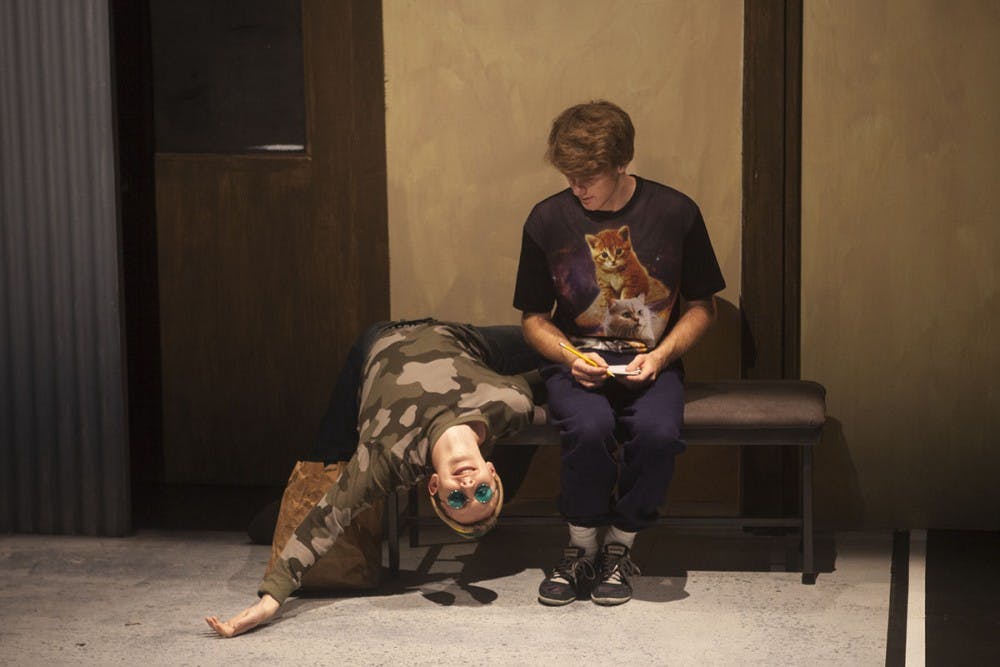Play Review: "Bob: A Life in Three Acts" - A

Justin Bernard, Jones College freshman, lounges next to Paul Dingus, Baker College sophomore, in the Visual and Dramatic Arts’ production of Bob: A Life in Five Acts, an offbeat comedy about the quest for the American dream.
{{tncms-asset app="editorial" id="e28bef62-b788-11e4-9cda-4f057b4f4a42"}}
f you are anything like me, then you know that you are destined for greatness. Or, at least, that is what our parents, teachers and academic advisors have told us for years. Either way, our success is ensured by a deeply ingrained American tradition and mythology of greatness, symbolized in the quintessential fantasy — the American dream. Bob: A Life in Five Acts is entirely about that fantasy: the expectations it generates, the people who perpetuate it and the disillusionment we all must face as we come to terms with the real world. The combination of great acting, immersive staging and hilarious writing make Bob: A Life in Five Acts a must-see production.
Bob: A Life in Five Acts stars Baker College sophomore Paul Dingus as Bob, a man born in a White Castle and raised on the road. From this less-than-typical beginning, the play quickly hits its stride and establishes a zany, fourth-wall-breaking, enormously referential, hilariously insane style that never lets up throughout its almost three-hour run time. As Bob grows from brilliant, naive dreamer to cynical hedonist over the course of the enormous road trip that is his life, he gets his pants stolen by a homeless woman, falls in love at a highway rest stop and works as a Starbucks barista, to name just a few of his misadventures. Dingus is perfectly suited for this role, ably shifting from naive child to cynical old man as the plot progresses and always managing to meet the level of intensity and humor demanded
by the plot.
Supporting and at times impeding Bob along his journey are the characters portrayed by the only other four members of the cast: Jones College freshman Justin Bernard, Jones College sophomore Carmella DeSerto, Wiess College junior Vicky Comesañas and McMurtry College sophomore Daniel Zdeblick. Each plays multiple roles throughout the production and provides narration and interpretive dances during the act breaks. Most notable is Bernard’s portrayal of a flamboyant, Eastern European animal trainer Bob meets in a railway car, a role to which he brings a singular energy and charm. Similarly impressive is the level of comedy Zdeblick manages to produce in his undeniably tragic role as the ex-boyfriend of Bob’s adopted mother. Of all of the crazy characters, however, DeSerto’s role as a kidnapped homicidal adolescent is without a doubt the funniest, even though she has only about five lines in her role.
If Bob is less than perfect, it is only because the volume of material it contains would be challenging for any actor. At times it was clear that the actors were struggling to remember lines, but the largely non sequitur nature of the dialogue allowed them to recover well from any such stumbles.
The actors benefit from the excellent and atypical staging; rather than being seated in the regular velvet seats in Hamman Hall, the audience is placed on stage, so close to the action that it is impossible not to be immersed in every scene. The set, composed only of two rolling shelves and a backdrop, is used ingeniously to represent at times a diner, a car, Mount Rushmore and an old civil rights-themed casino repurposed as a mansion. Along with three projectors and an excellent lighting setup, quick rearrangements of these two set pieces establish a unique mood and sense of place for each scene.
Though the acting in Bob is tremendous — each character played by the members of the chorus feels entirely fresh and inspires some new hilarity — the real power of the show comes from the way it parodies the traditional American mythology of success. The dialogue is rife with branding and references to famous Americans; not a scene goes by without mention of some specific car model or successful entrepreneur. This almost oppressive awareness of American “greatness” weighs upon Bob, as well as the audience, as he attempts to fulfill his mother’s expectation that he will be “a great man.” Though the tone of the show is kept light and humorous, Bob struggles with serious existential issues throughout, culminating in his total rejection of his former idealism in the final act. However, as with every other American trope that Bob addresses, this cynicism too is turned on its head and makes for excellent comedic fodder.
More from The Rice Thresher

Andrew Thomas Huang puts visuals and identity to song
Houston is welcoming the Grammy-nominated figure behind the music videos of Björk and FKA twigs on June 27.

Live it up this summer with these Houston shows
Staying in Houston this summer and wondering how to make the most of your time? Fortunately, you're in luck, there's no shortage of amazing shows and performances happening around the city. From live music to ballet and everything in between, here are some events coming up this month and next!

Review: 'Adults' couldn’t have matured better
Sitcoms are back, and they’re actually funny. FX’s “Adults” is an original comedy following a friend group navigating New York and what it means to be an “actual adult.” From ever-mounting medical bills to chaotic dinner parties, the group attempts to tackle this new stage of life together, only to be met with varying levels of success.

Please note All comments are eligible for publication by The Rice Thresher.